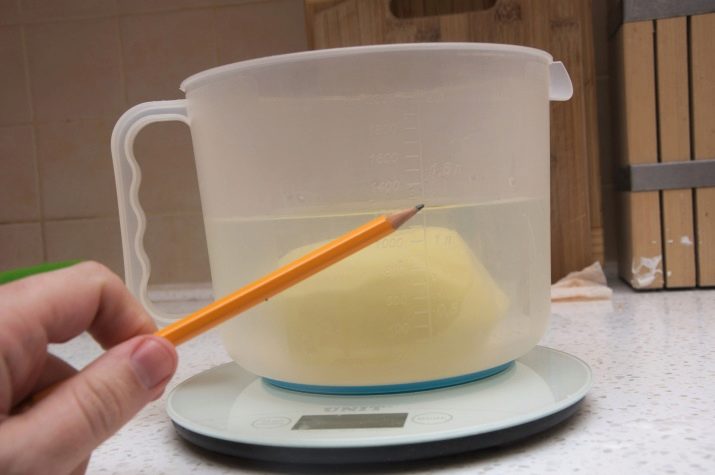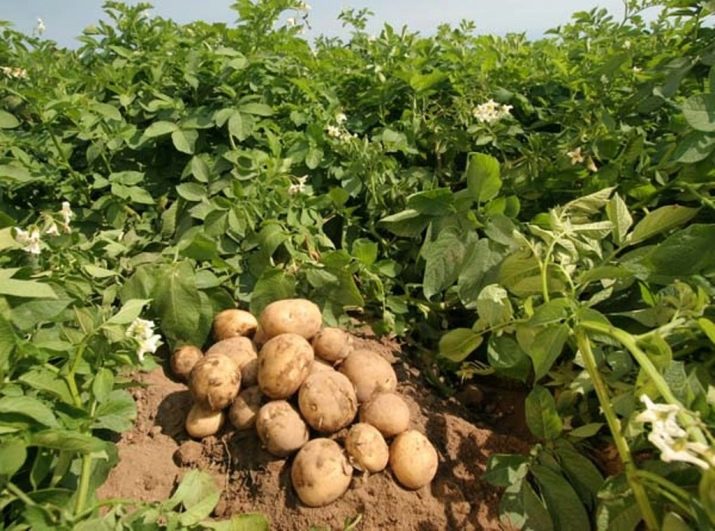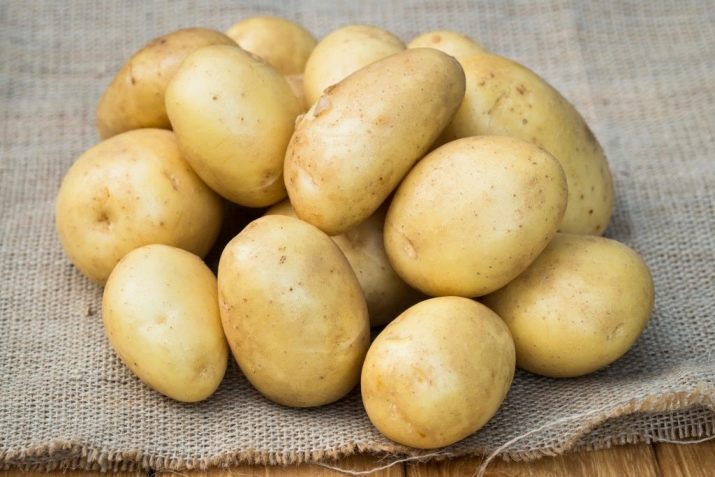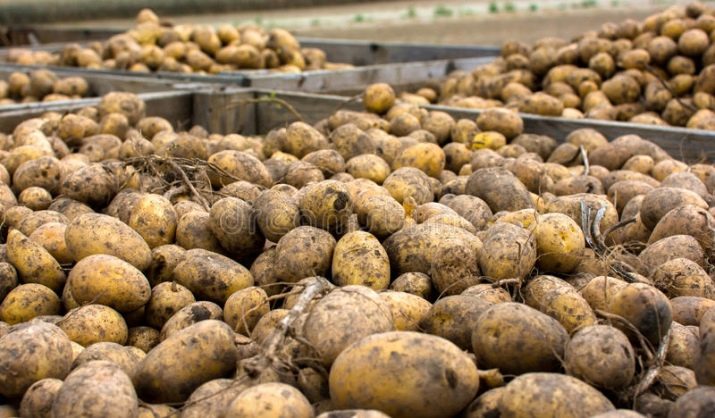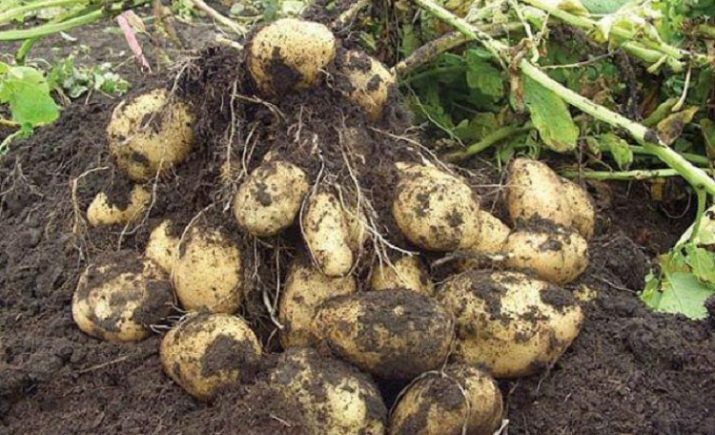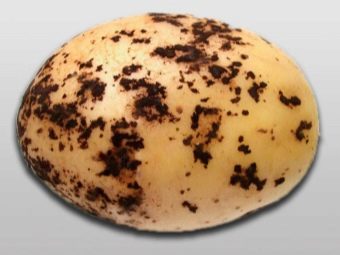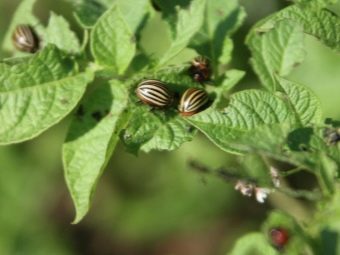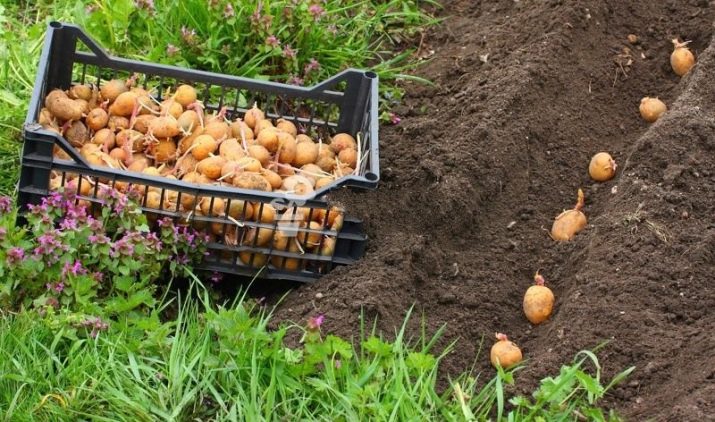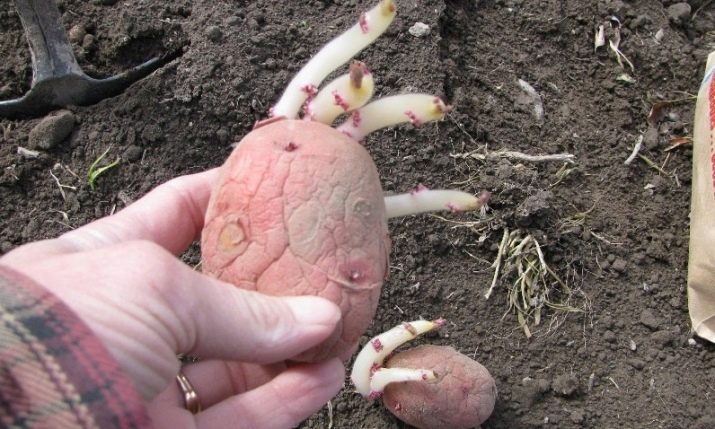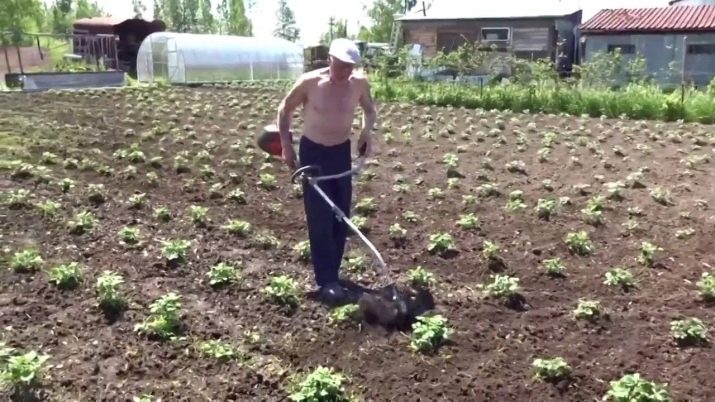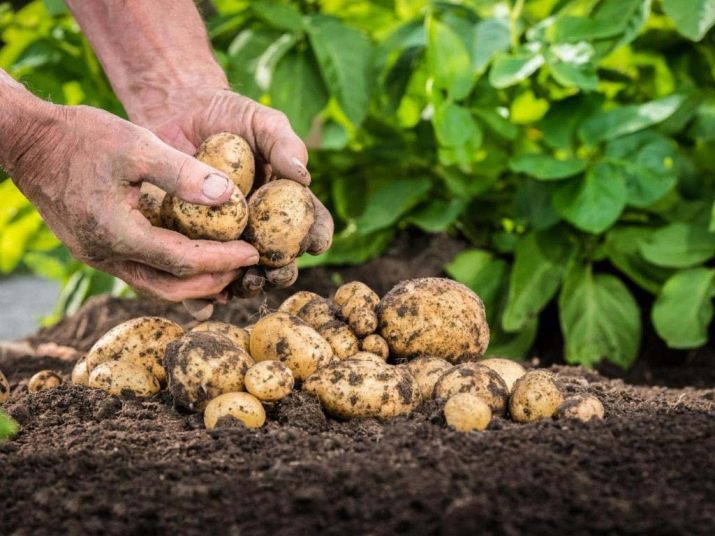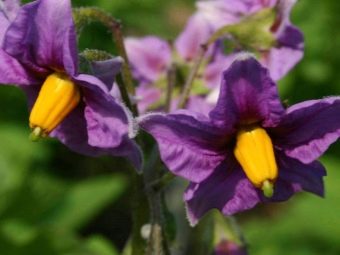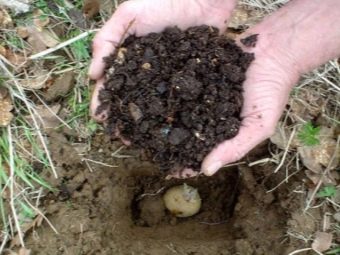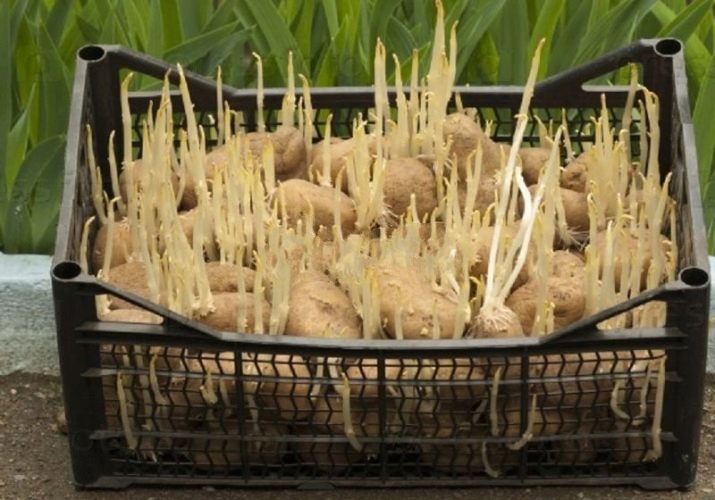Potato "Uladar": description of the variety and characteristics of cultivation

Despite the fact that the potato is not the original Russian culture, it is popular and in demand in our country.Today, a large number of its varieties are consumed, among which should be distinguished the Uladar potato, which is distinguished by its mass of merits and good yield.
Characteristic
Today private gardens are used for growing vegetables, while almost every summer resident or land owner is involved in potato cultivation. Potato breeders quite often give preference to any one variety, and have been breeding it for a long time, but in some cases new root varieties, such as Uladar, may be of interest. He appeared not so long ago in the garden cottages, but quickly became popular.
“Uladar” refers to early varieties of potatoes, the culture in Belarus was developed by crossing varieties “Zhivitsa” and “Kohl”. From the moment of germination to harvesting, it takes about two months. The average potato weight is about 140 grams.
Shrubs have an average height with a rather thick tops, so the area is very compact. Such a characteristic of the potato facilitates the process of caring for the root during the cultivation.
The leaves are green, with a slightly wavy edge. For growing for food purposes, the recommended planting density is an average of 50 thousand tubers per hectare.
The share of sugars in the root is about 0.42%, which has a positive effect on the taste of the product. Variety “Uladar” refers to the table type of potatoes, so it is widely grown in almost all regions of the country.
As for the characteristics of the root, it is worthwhile to elaborate on the main ones:
- on the potato grading scale, it ranks 7th out of ten;
- the grade differs in high productivity;
- the starch content in the fruit is 12.5%;
- tubers are well stored, without losing taste over time;
- the variety is able to produce two crops of root crops in one season.
Due to competent agricultural engineering, “Uladar” gives an early harvest. Potatoes can be consumed in different forms, and also left after storage for storage. According to reviews of gardeners, potatoes, under the right storage conditions, do not lose their taste until the next crop is harvested.
They dig it out after the foliage completely wilts, the foliage on the bushes dries and disappears, but the stems still retain green. This period is considered the most favorable for collecting tubers. With a uniform planting bushes, the harvest can be harvested by a combine - due to the heap of tubers on the bush, they are not damaged by the blades of the machine.
In temperate climates, potato harvesting takes place around the end of August or the beginning of September. These terms have averaged value, since in each case they directly depend on weather conditions in which the root crop has ripened.
Advantages and disadvantages
For the fullest description of the variety requires highlighting the advantages and disadvantages of the vegetable. The positive characteristics of the potato “Uladar” include the following characteristics:
- as a rule, almost the entire harvest of tubers will have the same size and oval shape, which has a positive effect on the commercial quality of the product;
- during the mechanical harvest, the potatoes are almost not injured;
- there is an opportunity to harvest a variety twice per season;
- due to the compact location of the tuber in the ground easier harvesting;
- due to the small amount of starch in the potato, it is perfect for cooking and eating;
- the grade is unpretentious to climatic conditions, well and quickly grows practically in any soil;
- the resulting hybrid variety has good resistance to viruses and diseases - is not afraid of cancer, scab, late blight of tubers;
- Due to the resistance to most diseases that affect vegetable crops, the plant requires a minimum of chemical treatment.
Among the minuses of the Uladar potato, it is worth noting the low resistance to rhizoctonia. In addition, like any other potato variety, it suffers from the invasions of the Colorado potato beetle, which destroys not only the tops, but also the root crop itself.
How to plant?
Culture is recommended for cultivation throughout Russia. Before planting a variety, it is necessary to fertilize the soil using mineral additives and humus. The latter needs about half a ton per hectare of land.
As for mineral fertilizers, the following substances will be useful for potatoes:
- phosphorus;
- nitrogen;
- potassium.
With the introduction of a large amount of nitrogen, the bushes will be different lush green mass and large stems, so the introduction of such feeding must be dosed out or completely excluded from the list of trace elements.
Before planting potatoes, you need to leave it for a while so that it sprouts a little. To achieve this effect, the seeds are left in a room with an air temperature of about 15 degrees. To eliminate the risk of planting unhealthy crops, potatoes should be thoroughly washed and inspected for signs of disease of the fetus before planting in the ground.
A little concentrated solution of hydrogen peroxide or potassium permanganate, in which seeds are kept for about 20-30 minutes, will help to get rid of the disease-causing microbes.
To harden the potatoes, after the first sprouts appear on it, the seeds are taken out onto the street. The size of the shoots should not exceed one centimeter, otherwise too long processes when planting simply break off.
It is worth noting an important feature of the variety “Uladar” - this crop can be planted by dividing the planting material into several parts. Usually one fruit is divided into 2-3 pieces, as a result, full-grown bushes grow on the garden, which give a good harvest.
Landing should be carried out in the period when the temperature of the soil will have a constant value of not less than + 10C. In addition to manure or compost, no additional fertilizer is required during planting. The holes should be excavated to a depth of about 5 centimeters, leaving a distance of between 20-30 centimeters. Rows of potatoes should be placed at a distance of 60 centimeters from each other.
Germinated potatoes are laid in the pits so that the shoots are directed upwards, after which the holes are covered with manure and earth. If a variety is planned to be grown in arid climates, the wells for sprouted potatoes are made deeper, by about 5-6 centimeters.
Care rules
Young potato bushes need a large amount of oxygen for productive growth and development, which is why an important task regarding care is regular loosening of the soil between the rows of vegetables.
The first shoots need to pile with the help of special garden tools. Work near the bushes should be done with great care so that during the filling of the soil does not damage the bush. Such an increase in the level of the soil around the stem will help to additionally feed the plant and protect it.
Weeding from weeds should also be regular, besides, mulching of the beds will help reduce their growth and the number of them. Grass between plants will retain moisture and will not allow harmful crops to grow.
The second hilling of the potato bushes will be needed during the formation of buds.
In order to prevent diseases, the bushes can be sprayed with hydrogen peroxide - in addition to protecting against pathogens, the solution will provide the culture with an additional portion of oxygen.
The first shoots need to be examined, and if Colorado beetles have appeared on the plants, gather insects to prevent laying eggs on the potatoes. If the plant is seriously affected by pests, it is worth performing treatment with insecticides.
To re-spray the composition of the pests need to be changed, because the Colorado potato beetle has a peculiarity of addiction to poisons.
Watering
The considered variety tolerates dry periods. Obligatory watering should be carried out immediately after planting, as well as during the growing season of the plant. Watering should not be the bushes themselves, but bring water into the aisle, thus it is possible to avoid soil erosion.
In the summer, when there is no precipitation, the potatoes will need additional feeding with moisture at least once every 14 days.
On the lack of moisture the plant will signal its appearance - the potato stalks will be lowered. But too abundant introduction of moisture can ruin the crop and the crop, so it is not worth watering the “Uladar” in abundance.
Top dressing
Fertilizer is introduced into the soil for the root crop in the fall, at the end of the potato harvest. It is necessary to dig up the soil, but not loosen the ground, but leave large clods on the site. Large soil in the winter will keep the snow, due to which the land will not become over-dried.
After digging up the soil, it is additionally fertilized with manure or compost. With the arrival of spring, when the snow masses finally disappear from the soil, the heated area should be re-dig.
This variety does not require the introduction of a large amount of feeding. But after planting, the plants need additional assistance for growth and development, and this can be done with the help of organic nutrient compounds. The most effective in this case would be manure or bird droppings. Liquid feeding is prepared in a ratio of 10: 1 in the first case, and 20: 1 in the second. It is better to fertilize potatoes with aqueous solutions, since the nutrients are much faster and in greater quantities reach the root system of the vegetable crop.
In order to influence the future harvest, “Uladar” is fed with compounds with potassium content during the growing season, the preparation of the solution is carried out according to the instructions.
It is worth considering several options for fertilizer culture.
- During the planting of seeds, together with the material for planting in the hole, they lower the wood ash and about 0.5-1 liters of humus. Depending on the type of soil, you can additionally use sand so that the soil is better able to pass water and air. Such additives will make the earth loose, so the bushes will grow much faster. And the sand will be able to protect the young plant from the wireworm.
- After 30 days after planting a variety, a fertilizer complex should be applied to the ground. It consists of 20 grams of superphosphate, 10 grams of potassium salt and 10 grams of urea, based on 1 square meter.
- During the formation of flowers, the root crop is fed with superphosphate. To do this, spray the plant. The solution is prepared according to this recipe - 3 spoons of the substance dissolve in 0.5 liters of hot water. After this concentrate insist 24 hours. For processing plants composition diluted with water in the ratio of 0.3: 10.
- In the flowering phase, the plant needs urea, the fertilizer is applied by foliar feeding. The composition is prepared by diluting 50 grams of the product in 10 liters of purified water.
- When the potatoes fade, fertilizing the culture is the introduction of boron and magnesium. Preparations containing these substances are sold in any specialized department of goods for the garden. The above microelements have a positive effect on the taste of potatoes, therefore, recommended for use.
As regards precautionary measures, in the course of fertilizing a variety, ammonium sulphate and dolomite flour should be avoided.
Useful tips
The introduction of organic fertilizers will help in the future to obtain a high yield of potatoes. However, the application rate of feeding varies depending on the type of soil in which the culture will grow. Experienced gardeners recommend to carefully consider this feature. So, for a sandy soil, you will need about 50 kilograms of manure, and for heavy soils, you usually use about 30 kilograms per square meter.
If you plan to plant potatoes in sandy soil, planting material should be germinated in advance in order to plant at the same time as grain crops.
Heavy soil requires a later landing, the timing will be different for at least one week.
There are a number of recommendations for landing:
- during the early planting, potatoes are deepened into the ground by 5-6 centimeters;
- if the material is planted using the ridge method, the planting depth should be about 8 centimeters;
- tubers are planted in the damp earth in holes, about 13 centimeters deep.
All beds must be kept clean, so regular weeding should be carried out on the site. Harvesting is carried out shortly after the appearance of green tops. Store potatoes in mesh bags.
Review this and other popular varieties of potatoes, see the following video.


